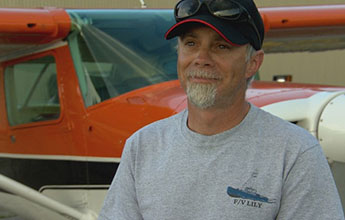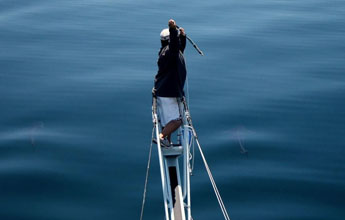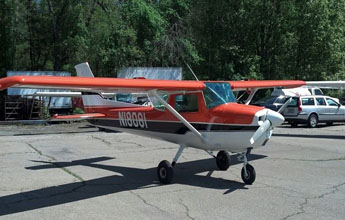
Boston Lineman Flies Spotter
|
 |
| Boston 104 lineman Mark Brochu, one of a family of 48 IBEW members, is a spotter pilot for Captain Bill Muniz on the popular National Geographic show Wicked Tuna. |
The 14-year Boston Local 104 lineman, who competed in motocross as a kid, has been a general foreman on some of the most massive substations in the Northeast.
And, when he’s not supplying electrical power to his neighbors, Brochu is flying a 1973 Cessna 150 L as the spotter pilot for the Lily, a boat captained by harpoon-wielding Bill “Hollywood” Muniz who competes with fellow commercial fishermen on National Geographic’s popular reality show, Wicked Tuna. The show is viewed regularly by millions on the National Geographic Channel and Nat Geo Mundo.
Tuna fishing can be lucrative. Sushi-grade Bluefin brings in $30 a pound. That’s $20,000 for one big fish.
But, for Brochu and Muniz, it’s not just about money. Both have played key roles helping marine scientists study the migratory patterns of tuna and their susceptibility to warming ocean waters. And both have helped save the lives of whales entangled in nets they have encountered while fishing.
“Fishing, flying planes and working as a lineman are three of the most dangerous occupations,” says Brochu, “But I don’t take foolish chances.” His home port’s dramatic history punctuates the need for safe work practices.
Muniz and Brochu fish out of Gloucester, Mass., the nation’s oldest seaport. Danger is tragically represented by a memorial to 10,000 local residents who have died at sea and is even more famously portrayed in the book, The Perfect Storm by Sebastian Junger and the popular movie of the same name, starring George Clooney.
One of only 40 fishermen in the Northeast who use harpoons to catch tuna, Muniz requires exact knowledge of a fish’s position to get in close enough for the kill shot. “Mark is good at distinguishing what the fish are doing and how big they are,” says Muniz. “We don’t want to kill anything we can’t sell. We want to fish responsibly.”
Before taking off to help Muniz find fish, Brochu checks satellite links to get up-to-the-minute weather reports. Modern radar has made his job safer. “I can time myself to get around rough weather if I have to,” he says.
 |
| The Lily Captain Bill Muniz is one of only 40 fishermen in the Northeast who use harpoons to catch tuna. |
Balancing weather reports with extraordinary fuel consumption to sustain eight or 10 hours over the water, he heads out and begins to look in the distance for telltale wakes made by tuna, while also looking straight down for movement. “Spotter pilots are mostly self-taught,” says Brochu, who picked up some skills from one of his father’s friends who piloted a plane spotting swordfish for his own crew. Brochu says his 13-year-old son is already showing interest in picking up the spotter pilot trade.
When he spots fish, Brochu, one of a family of 48 linemen and other utility workers that was profiled in Powerline Magazine,“steers” Muniz to the catch giving directions using numbers on a clock or the number of boat lengths away.
“Working with the captain is a lot like linework,” says Brochu. “We need to coordinate and factor in weather conditions. No matter what is written down or on our meters, talking and communicating is everything,” says Brochu, who, when he’s grounded due to weather, helps rebuild aircrafts with the owner of his fixed base of operations.
“Mark[ie] is a big part of our operation. He’s one of the best pilots around and gives me a lot more opportunities to throw the harpoon,” says Muniz, who, before he bought his own boat in 1987, worked on the Andrea Gail, the boat lost in The Perfect Storm in 1991.
“I was rod and reeling until 2001 when I decided to try harpooning, and convinced Mark to go up for me. He’s like a brother now, more like part of my family,” says Muniz. Their extended family has come to include marine scientists studying the tuna population.
Bluefin tuna have extremely wide migratory patterns spanning thousands of miles. In the 1990s, Brochu was one of 13 spotter pilots who helped marine scientists locate and count schools of tuna by using cameras linked to laptops and global positioning systems.
 |
| Lineman Mark Brochu picked up spotter plane skills he employs flying his 1973 Cessna 150 L years ago from a family friend. |
“Mark is a superb spotter pilot who is really good with data collection,” says Molly Lutcavage, senior scientist at the Edgerton Research Lab at the New England Aquarium who flew with him.
Lutcavage says Brochu and other spotter pilots played a decisive role in the early 1990s when government fishery managers in the Northeast mandated that commercial catch limits be cut by 50 percent due to declining schools of tuna. The pilots refuted the manager’s estimates of the tuna population and requested members of the white whale team at the New England Aquarium to fly with them to survey the Bluefin schools.
“It became immediately clear to the scientists that the [managers’] estimates were faulty,” says Lutcavage, whose mother was an IBEW manufacturing branch member at Wagner Industries in her native Hazleton, Pa. The original quotas remained in place.
“Our scientific partnerships with fishermen and pilots are so important,” says Lutcavage. Ongoing cooperation, she says, is needed to document trends. Since 2004, Bluefin populations have declined in coastal Maine, for instance, and become more plentiful off the coast of Nova Scotia. Warming seas are suspected.
Follow Mark Brochu and Bill Muniz and their fishing competitors on Wicked Tuna, Season Four, premiering in February.
![]()